This article received a 2018 Robert G. Fenley Writing Award from the Group on Institutional Advancement of the Association of American Medical Colleges.]
What You Will Learn:
- Brigham researchers explain how they turn scientific questions into new standards of medicine.
- Examples of Brigham-led studies in orthopedic medicine and psychiatry show how randomized controlled trials are the gold standard of clinical research.
- Research leaders say academic medical centers that invest in clinical research provide better patient care.
The first known controlled clinical trial was conducted on the British Royal Navy ship Salisbury in 1747. The ship’s surgeon, a Scotsman named James Lind, was shocked by how many sailors were sick with bleeding gums, joint and muscle weakness, and painful sores. Hoping to reduce their suffering, Lind assigned a dozen of the sailors in pairs to ingest one of six different daily regimens: cider, vinegar, sea water, diluted sulphuric acid, two oranges and a lemon, or a paste made up of garlic, mustard seed, and dried radishes. Within a week, the two sailors in the citrus group had recovered, confirming a remedy for scurvy.
Getting It Right
Clinical trials measure how living, human bodies—particularly sick and injured ones—respond to interventions. They are the riskiest, most expensive form of medical research, and yet the pivotal step to delivering safe and effective medications, surgical procedures, medical devices, physical and behavioral therapies, and even diets.
Brigham and Women’s Hospital (BWH) has 1,500 primary investigators (PIs) leading research teams in virtually every area of medicine. Shalender Bhasin, MD, director of the Center for Clinical Investigation (CCI), is focused on facilitating clinical research at BWH to translate scientific ideas into patient care.
“We are fortunate here at the Brigham to have extraordinary talent and ideas, and while ideas are necessary, they are insufficient to turn science into medicine,” he says. “Ideas must be converted into research protocols and tested rigorously in clinical trials. Generating proof of concept in clinical trials is really hard. Converting an idea into a new product is many orders of magnitude more difficult.”
Developing a new drug can take 10 to 15 years and cost up to $2 billion—largely fueled by soaring expenses with conducting clinical trials, which can require treating and monitoring thousands of patient volunteers. However, clinical trials aren’t solely a means to develop new drugs. What PIs discover in clinical trials ultimately leads to better healthcare, helping physicians treat their patients; patients make informed decisions; families and communities adopt healthy practices; and scientists form new questions.
“We have to challenge old assumptions—the standards of practice that are accepted but not backed by solid evidence,” says Lindsey R. Baden, MD, the CCI’s associate director and the director of clinical research in the Division of Infectious Diseases. “That is not for the faint of heart, but it is what we must do to get it right.”
Fate and Design
In 2009, Bob O’Keefe squatted down to pick something up when he felt his knee pop and give under his weight. He quickly made an appointment at BWH to see his rheumatologist, Jeffrey Katz, MD, MMSc, and learned he had torn his meniscus.
“Dr. Katz walked me through all the possible treatment strategies to repair the tear, including an invitation to join a clinical trial he was running,” O’Keefe says.
Katz was recruiting osteoarthritis patients with meniscus tears to participate in a multicenter clinical trial. Nicknamed MeTeOR (Meniscal Tear in Osteoarthritis Research), the study randomly assigned a group of patients to surgery on the injured meniscus, followed by postoperative rehabilitation therapy. Another group of patients were given an eight-week course of standard physical therapy alone. The goal was to see if surgery was superior to non-invasive approaches.

“Many physicians considered surgery the standard treatment for meniscal tear,” Katz says. “Our study and others done around the same time in Europe and Asia suggested that physical therapy is as effective for most patients.”
Led by Katz, MeTeOR was conducted over five years across seven study centers around the United States. It employed dozens of clinical and surgical investigators and research staff and involved more than 300 patient volunteers. For a study of this scale, the design had to be perfect.
Just as Lind did with his scurvy patients, the MeTeOR team used the most rigorous clinical research design: randomizing patients to the different interventions to eliminate factors that might lead to incorrect conclusions about each treatment’s effects.
Successful research design also meant finding the right patient volunteers, whose commitment and motivation are as crucial as their underlying medical problems.
“I was thrilled to be asked,” recalls O’Keefe, who, in his mid-60s, had never participated in clinical research. “I swore if I ever had the opportunity to get involved in a trial, I would take it. It was exciting to help them get to the bottom of a treatment question that is meaningful to a lot of people, and be a part of something bigger than myself.”
And it takes a dedicated team to launch a clinical trial, says biostatistician and study co-investigator Elena Losina, PhD. As the team’s methods guru, Losina made sure the study could produce solid data and harmonize with the hospital’s normal operations.
We had to ensure surgeons were willing to randomize their patients to surgery, which is a hard thing for surgeons to do.
Elena Losina, PhD
“We had to ensure surgeons were willing to randomize their patients to surgery, which is a hard thing for surgeons to do,” says Losina. “We were lucky to work with Brigham surgeons who were absolute champions during MeTeOR. We needed to recruit 350 [BWH] patients to produce enough meaningful data. With help from our clinical collaborators and a lot of work, we got 351.”
A year before any volunteers could be enrolled, MeTeOR’s research protocol—the document mapping the study’s aims and procedures—had to pass several safety reviews including the hospital’s Institutional Review Board and an independent Data Safety Monitoring Board assembled by the U.S. National Institutes of Health (NIH), which funded the study.
“A prospective, randomized controlled trial involving an intervention in humans is a supertanker,” says Baden. “If you designed it wrong four years ago, you are stuck with it now. That’s the challenge with clinical research today. You cannot redesign the experiment in a month if you find things aren’t working out as planned.”
Baden says for researchers to truly advance the art of medicine, they must study the best model. Humans introduce uncertainty into clinical research, though: the placebo effect, the phenomenon when a person given an ineffectual treatment, such as a sugar pill, experiences a perceived or actual improvement in their condition.
Confounding Variables
“The placebo effect exists to some extent in all clinical research,” says David Wolfe, MD, MPH, associate vice chair of the Department of Psychiatry, who studies treatments for depression. “It is especially strong in psychiatry.”
As a clinician, Wolfe knows only a third of patients respond meaningfully to a traditional antidepressant, and side effects are common.
“That’s how I got interested in clinical research,” Wolfe says. “Our current medications are far from perfect. About half of clinical trials that have been done for currently approved antidepressants were actually negative studies—meaning the results from the treatment being tested were no different from the placebo results.”
Wolfe and his team are studying other promising depression treatments, including an anti-inflammatory injection currently used for patients with arthritis and a neuroprotective medication originally developed to treat amyotrophic lateral sclerosis (ALS). He is also fascinated by early evidence that the 60-year-old anesthesia drug ketamine could be a game changer for patients with severe depression.

“The placebo effect diminishes after six weeks on an antidepressant, and people usually start reporting some treatment effect after a few weeks,” he says. “But a medication like ketamine blows those results out of the water.”
In early studies, patients with suicidal thoughts who went to the emergency room were given ketamine. Instead of weeks to months, they responded within minutes to an hour.
“Clearly, ketamine has a different mechanism than the typical serotonin drug,” he says. “We know what it can do, but not what contributes to that effect. It’s a new way of looking at how we treat depression.”
Wolfe and his colleagues at Brigham and Women’s Faulkner Hospital hope to test medications with unique antidepressant activity, like ketamine, in the inpatient psychiatry unit to see if it helps patients recover quickly and safely during a major depressive episode.
“If medications like ketamine are proven safe and effective, they could help de-escalate suicidal thoughts quickly and effectively enough for the patient to shorten their hospitalization, or even leave the ER with an intensive outpatient follow-up plan,” says Wolfe. “But all of these questions remain unanswered. It’s exciting how many studies are out there waiting to be done in this area.”
About half of clinical trials that have been done for currently approved antidepressants were actually negative studies—meaning the results from the treatment being tested were no different from the placebo results.
David Wolfe, MD, MPH
Getting Results
In 2013, findings from the MeTeOR study were published in the New England Journal of Medicine.
“I was pleased with my outcome,” says O’Keefe, “but I had no idea how the other study volunteers were doing. I was eager to see how my results compared.”
The trial did not find statistically different results between the group assigned to surgery and the group assigned to physical therapy. But following the surgery, 30 percent of the patients who were randomized to physical therapy eventually decided to undergo surgery.
“That pointed to important implications,” says Katz. “Surgery might not be the physicians’ first choice for patients based on that evidence, but it’s important to recognize patient preferences. This trial provided useful data to treat orthopaedic conditions and understand patients’ attitudes toward their treatment.”
In BWH’s new Building for Transformative Medicine (BTM), the proximity of clinics and research space means investigators can more easily share their data and find new inspiration to design better clinical trials. In their new research space in the BTM, Losina and Katz are planning a spinoff study from MeTeOR, called TEMPO (Treatment of Meniscal Problems in Osteoarthritis). The TEMPO team will test whether the positive results in MeTeOR’s physical therapy group were due to a genuine treatment effect or the placebo effect.
“Only a portion of chronic diseases like osteoarthritis are curable, so we needed to figure out how to help patients live with these diseases and develop coping strategies,” says Katz.
A Breakthrough Machine
When he visualizes clinical research of the near future, Bhasin has electric cars on the brain.
“The Tesla looks like the same car that’s been built for decades, but inside it has been re-engineered with many fewer moving parts. That’s how I see the hospital’s clinical research enterprise,” says Bhasin. “We are striving to build infrastructure for tomorrow that works faster, better, more efficiently, and that meets regulatory demands all within constrained resources.”
The CCI leaders also bear in mind the experience of the 10,000 patient volunteers enrolled at any given time in trials across BWH. The Clinical Trials Center in the BTM gives patient volunteers a one-stop shop to enroll and participate in research.
“Institutions that invest in clinical research provide better clinical care,” says Baden. “It ups the game for clinical care because it creates an environment, culture, and conversation around high-quality evidence above all else.”
Yet in spite of everything patient volunteers and scientists give to clinical research, a 2007 Institute of Medicine report found fewer than half of medical treatments on the market are supported by evidence they work for the patients to whom they are targeted.
The enormous cost of launching late-phase trials—as well as the high fail rate of studies that test first-in-human treatments— have made government, industry, and other research funders more risk-averse. The burden falls on academic medical centers to pursue research that will meet FDA approval and bring breakthrough medicines to patients in need.
“As difficult and expensive as clinical research is,” Bhasin explains, “there is no alternative to doing it if we want to answer questions that are important for public health and to people in their daily lives.”




